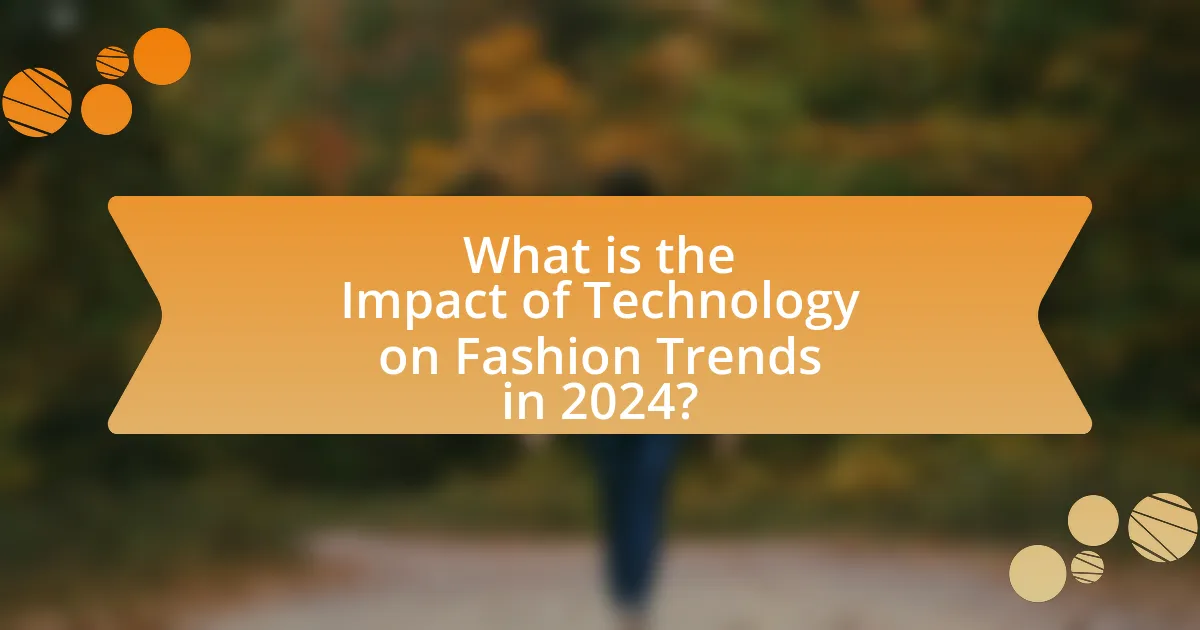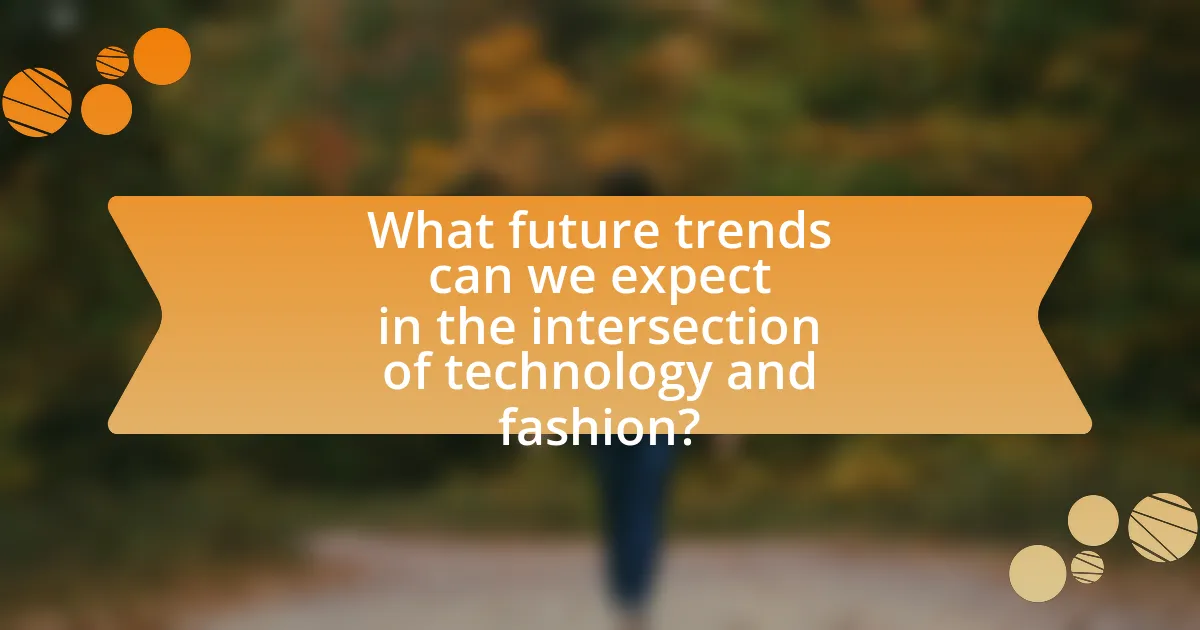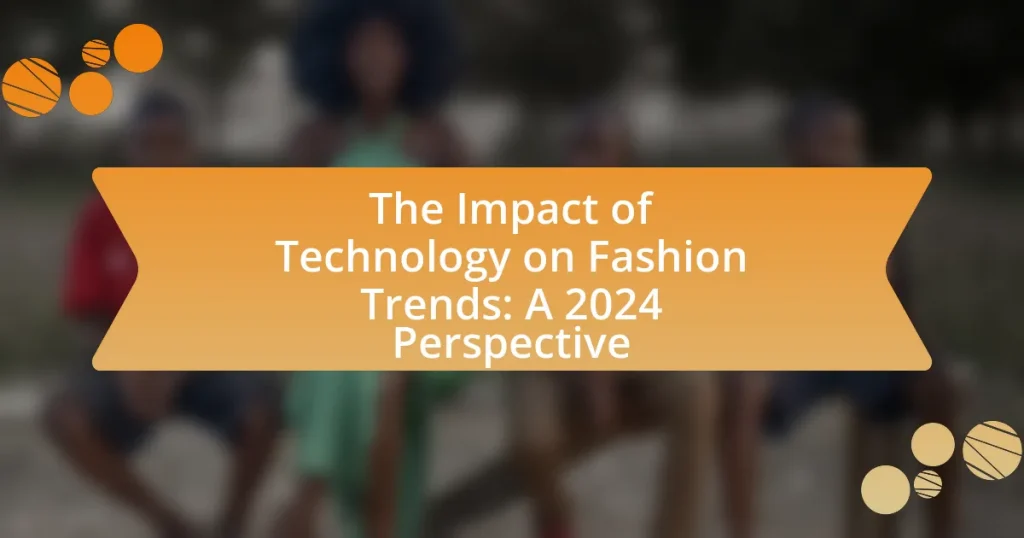The article examines the significant impact of technology on fashion trends in 2024, highlighting advancements in artificial intelligence, augmented reality, and sustainable materials. It discusses how AI-driven design tools enhance consumer personalization and trend prediction, while augmented reality applications improve online shopping experiences. The article also addresses the historical influence of technology on fashion, key technological advancements shaping the industry, and the growing importance of sustainability. Additionally, it explores consumer behavior changes driven by these innovations and the implications of emerging technologies like blockchain and smart textiles in promoting transparency and eco-friendliness in fashion.

What is the Impact of Technology on Fashion Trends in 2024?
The impact of technology on fashion trends in 2024 is significant, as advancements in artificial intelligence, augmented reality, and sustainable materials are reshaping the industry. AI-driven design tools enable brands to analyze consumer preferences and predict trends more accurately, leading to personalized shopping experiences. Augmented reality applications allow customers to virtually try on clothing, enhancing engagement and reducing return rates. Additionally, the use of sustainable materials, facilitated by technological innovations, is becoming a priority for brands aiming to meet consumer demand for eco-friendly products. According to a report by McKinsey & Company, 67% of consumers consider sustainability when making fashion purchases, highlighting the importance of technology in addressing these preferences.
How has technology historically influenced fashion trends?
Technology has historically influenced fashion trends by enabling new materials, production techniques, and communication methods that shape consumer preferences and industry practices. For instance, the invention of the sewing machine in the 19th century revolutionized garment production, allowing for mass production and the rise of ready-to-wear clothing, which made fashion more accessible to the general public. Additionally, the introduction of synthetic fibers like nylon in the 1930s expanded design possibilities and affordability, leading to new styles and trends. The advent of the internet in the late 20th century transformed how fashion is marketed and consumed, facilitating the rise of fast fashion and online shopping, which have significantly altered consumer behavior and trend cycles.
What key technological advancements have shaped the fashion industry?
Key technological advancements that have shaped the fashion industry include the rise of digital design tools, 3D printing, and e-commerce platforms. Digital design tools, such as Adobe Illustrator and CLO 3D, have revolutionized the design process, allowing designers to create and visualize garments more efficiently. 3D printing technology has enabled the production of intricate designs and customized clothing, reducing waste and production time. E-commerce platforms have transformed retail by providing brands with direct access to consumers, facilitating global reach and personalized shopping experiences. According to a report by McKinsey & Company, the global online fashion market is projected to reach $1 trillion by 2025, highlighting the significant impact of these technological advancements on the industry.
How do consumer behaviors change with technological innovations?
Consumer behaviors change significantly with technological innovations by increasing convenience, enhancing personalization, and shifting purchasing channels. For instance, the rise of e-commerce platforms and mobile shopping apps has led to a preference for online purchases over traditional retail, with 2022 data showing that 20% of all retail sales in the U.S. occurred online. Additionally, advancements in artificial intelligence allow brands to offer personalized recommendations, which can increase customer engagement and sales; a study by McKinsey found that personalization can lead to a 10-30% increase in revenue. Furthermore, social media platforms have transformed how consumers discover and interact with fashion brands, with 54% of social media users stating they use these platforms to research products before buying. These shifts illustrate how technological innovations directly influence consumer preferences and behaviors in the fashion industry.
What are the current technological trends affecting fashion in 2024?
Current technological trends affecting fashion in 2024 include the rise of artificial intelligence (AI) in design and personalization, the integration of augmented reality (AR) for virtual try-ons, and the use of blockchain for supply chain transparency. AI is increasingly utilized by brands to analyze consumer data and predict trends, enhancing the customization of products to individual preferences. AR technology allows customers to visualize clothing on themselves through apps, improving the online shopping experience and reducing return rates. Additionally, blockchain technology is being adopted to ensure authenticity and traceability of materials, addressing sustainability concerns and enhancing consumer trust. These trends are reshaping the fashion industry by making it more efficient, personalized, and transparent.
How is artificial intelligence transforming fashion design?
Artificial intelligence is transforming fashion design by enabling data-driven decision-making and enhancing creativity through predictive analytics and automation. AI algorithms analyze consumer preferences, trends, and historical data to forecast styles and optimize inventory management, leading to more tailored collections. For instance, companies like Stitch Fix utilize AI to personalize clothing recommendations, resulting in increased customer satisfaction and reduced returns. Additionally, AI-powered design tools, such as those developed by Adobe, assist designers in generating innovative patterns and styles, streamlining the creative process. This integration of AI not only improves efficiency but also fosters a more responsive and dynamic fashion industry.
What role does social media play in shaping fashion trends?
Social media significantly influences fashion trends by providing a platform for rapid dissemination and democratization of style ideas. Platforms like Instagram and TikTok allow influencers and brands to showcase new looks, which can quickly gain traction among users, leading to viral trends. For instance, a study by the Fashion Institute of Technology found that 70% of consumers are influenced by social media when making fashion purchases, highlighting its critical role in shaping consumer behavior and preferences. This immediate feedback loop enables designers to adapt their collections based on real-time audience reactions, further solidifying social media’s impact on the fashion industry.
Why is sustainability a critical focus in fashion technology?
Sustainability is a critical focus in fashion technology because it addresses the environmental and social impacts of the industry, which is one of the largest polluters globally. The fashion industry contributes to approximately 10% of global carbon emissions and is responsible for significant water consumption and waste generation. By integrating sustainable practices and technologies, such as eco-friendly materials and circular production methods, the industry can reduce its ecological footprint and promote ethical labor practices. This shift is essential not only for compliance with increasing regulatory pressures but also for meeting consumer demand for responsible and transparent brands, as studies show that 66% of consumers are willing to pay more for sustainable products.
How do technological innovations promote sustainable practices in fashion?
Technological innovations promote sustainable practices in fashion by enabling more efficient production processes, reducing waste, and facilitating the use of eco-friendly materials. For instance, advancements in 3D printing allow for on-demand manufacturing, which minimizes overproduction and excess inventory. Additionally, technologies such as blockchain enhance transparency in supply chains, allowing consumers to verify the sustainability of materials used. According to a report by McKinsey & Company, the adoption of digital technologies in fashion can reduce greenhouse gas emissions by up to 30% by 2030. These innovations collectively contribute to a more sustainable fashion industry by optimizing resource use and promoting responsible consumption.
What are the challenges of integrating technology with sustainability in fashion?
Integrating technology with sustainability in fashion faces several challenges, including high costs, lack of standardization, and consumer awareness. High costs arise from the initial investment required for sustainable technologies, which can deter brands from adopting them. Lack of standardization in sustainable practices and technologies complicates the integration process, as brands may struggle to align their efforts with industry benchmarks. Additionally, consumer awareness and demand for sustainable products remain low, making it difficult for brands to justify the investment in sustainable technologies. According to a 2021 McKinsey report, only 30% of consumers prioritize sustainability when making fashion purchases, highlighting the need for increased consumer education and engagement in sustainable practices.
How do fashion brands leverage technology for consumer engagement?
Fashion brands leverage technology for consumer engagement by utilizing digital platforms, social media, augmented reality, and data analytics to create interactive and personalized experiences. For instance, brands like Gucci and Nike have implemented augmented reality features in their mobile apps, allowing consumers to virtually try on products, enhancing the shopping experience and increasing engagement. Additionally, data analytics enables brands to understand consumer preferences and behaviors, allowing for targeted marketing strategies that resonate with specific audiences. According to a report by McKinsey & Company, 75% of fashion companies are investing in digital technologies to improve customer engagement, demonstrating the industry’s commitment to integrating technology for enhanced consumer interaction.
What are the implications of virtual reality and augmented reality in fashion?
Virtual reality (VR) and augmented reality (AR) significantly transform the fashion industry by enhancing customer experiences and streamlining design processes. These technologies allow consumers to virtually try on clothing and accessories, reducing return rates and increasing purchase confidence; for instance, a study by Deloitte found that AR can increase conversion rates by up to 40%. Additionally, VR enables designers to create immersive fashion shows and presentations, reaching global audiences without the constraints of physical venues. This shift not only broadens market access but also fosters innovative marketing strategies, as brands can engage customers in interactive and personalized ways.

What are the specific impacts of technology on consumer behavior in fashion?
Technology significantly influences consumer behavior in fashion by enhancing personalization, improving accessibility, and facilitating social interaction. Personalization is driven by data analytics and artificial intelligence, allowing brands to tailor recommendations based on individual preferences, which increases customer engagement and satisfaction. For instance, a study by McKinsey & Company found that personalized experiences can lead to a 10-30% increase in sales.
Accessibility has improved through e-commerce platforms and mobile applications, enabling consumers to shop anytime and anywhere, which has expanded market reach and convenience. According to Statista, global e-commerce sales in the fashion sector are projected to reach $1 trillion by 2025, highlighting the shift in consumer purchasing behavior.
Social interaction is enhanced through social media platforms, where consumers engage with brands and influencers, shaping their purchasing decisions. Research from the Pew Research Center indicates that 72% of teenagers use Instagram, making it a powerful tool for fashion marketing and consumer influence.
Overall, technology reshapes consumer behavior in fashion by driving personalization, increasing accessibility, and fostering social engagement, leading to significant changes in how consumers interact with fashion brands.
How do online shopping experiences influence fashion choices?
Online shopping experiences significantly influence fashion choices by providing consumers with immediate access to a vast array of styles and trends. The convenience of browsing multiple retailers, reading reviews, and viewing detailed product images allows shoppers to make informed decisions, which can lead to increased purchases of trendy items. According to a 2022 study by McKinsey & Company, 70% of consumers reported that online shopping platforms helped them discover new fashion trends, highlighting the role of digital experiences in shaping consumer preferences.
What technologies enhance the online shopping experience?
Technologies that enhance the online shopping experience include artificial intelligence, augmented reality, and mobile applications. Artificial intelligence personalizes shopping by analyzing user behavior and preferences, leading to tailored recommendations; for instance, 35% of Amazon’s revenue is generated from its recommendation engine. Augmented reality allows customers to visualize products in their environment, significantly increasing engagement; a study by Shopify found that 40% of consumers are willing to pay more for a product if they can experience it through AR. Mobile applications streamline the shopping process, offering features like one-click purchasing and push notifications, which can increase conversion rates by up to 20%.
How do personalized recommendations affect consumer purchasing decisions?
Personalized recommendations significantly influence consumer purchasing decisions by increasing the likelihood of purchases through tailored suggestions. Research indicates that 80% of consumers are more likely to buy a product when it is recommended based on their preferences and past behaviors. This personalization enhances the shopping experience, making it more relevant and engaging, which in turn drives higher conversion rates. Additionally, a study by McKinsey found that personalized recommendations can lead to a 10-30% increase in sales, demonstrating their effectiveness in shaping consumer behavior.
What is the significance of data analytics in understanding fashion trends?
Data analytics is significant in understanding fashion trends as it enables brands to identify consumer preferences and predict future trends based on data-driven insights. By analyzing vast amounts of data from social media, sales figures, and online searches, fashion companies can discern patterns in consumer behavior, allowing them to tailor their offerings to meet market demands effectively. For instance, a report by McKinsey & Company highlights that data analytics can improve forecasting accuracy by up to 50%, leading to better inventory management and reduced waste. This capability not only enhances profitability but also fosters innovation in design and marketing strategies, making data analytics an essential tool in the fashion industry.
How do brands utilize data to predict fashion trends?
Brands utilize data to predict fashion trends by analyzing consumer behavior, social media interactions, and sales patterns. They employ advanced analytics and machine learning algorithms to process vast amounts of data from various sources, including online shopping habits, search engine queries, and influencer activities. For instance, a report by McKinsey & Company highlights that data-driven insights can lead to a 10-15% increase in sales by aligning product offerings with emerging trends. Additionally, brands monitor real-time feedback from platforms like Instagram and TikTok to identify shifts in consumer preferences, enabling them to adapt their collections accordingly. This data-centric approach allows brands to make informed decisions, reducing the risk of overproduction and enhancing customer satisfaction.
What are the ethical considerations of using consumer data in fashion?
The ethical considerations of using consumer data in fashion include privacy, consent, and data security. Fashion brands must ensure that they collect consumer data transparently and with explicit consent, as failure to do so can lead to violations of privacy rights. According to the General Data Protection Regulation (GDPR), companies are required to protect personal data and uphold consumer rights, which emphasizes the importance of ethical data handling practices. Additionally, brands must consider the implications of data usage on consumer trust; unethical practices can damage brand reputation and lead to loss of customer loyalty. Furthermore, the potential for data misuse, such as discriminatory pricing or targeted marketing based on sensitive information, raises significant ethical concerns that fashion companies must address to maintain ethical standards in their operations.

What future trends can we expect in the intersection of technology and fashion?
Future trends in the intersection of technology and fashion include the rise of smart textiles, augmented reality (AR) shopping experiences, and sustainable fashion technologies. Smart textiles, which integrate sensors and connectivity, will enable garments to monitor health metrics and adapt to environmental conditions, enhancing user experience. Augmented reality will transform how consumers shop by allowing virtual try-ons and interactive experiences, increasing engagement and reducing return rates. Additionally, advancements in sustainable technologies, such as 3D printing and biodegradable materials, will address environmental concerns, making fashion more eco-friendly. These trends are supported by industry reports indicating a growing consumer demand for innovation and sustainability in fashion, with the global smart textiles market projected to reach $5.3 billion by 2024.
How will advancements in wearable technology shape fashion trends?
Advancements in wearable technology will significantly shape fashion trends by integrating functionality with style, leading to the emergence of smart clothing and accessories. As consumers increasingly seek products that enhance their lifestyle, brands are innovating to create garments that monitor health metrics, provide connectivity, and offer personalized experiences. For instance, the global market for smart textiles is projected to reach $5.3 billion by 2024, indicating a growing consumer demand for fashion that serves dual purposes. This trend will encourage designers to blend aesthetics with technology, resulting in collections that prioritize both form and function, ultimately transforming the fashion landscape.
What are the potential impacts of smart textiles on fashion design?
Smart textiles significantly impact fashion design by enabling innovative functionalities such as temperature regulation, moisture management, and health monitoring. These textiles integrate technology into fabrics, allowing designers to create garments that respond to environmental conditions or user needs. For instance, a study by the Massachusetts Institute of Technology highlighted that smart textiles can change color based on temperature, enhancing aesthetic appeal while providing practical benefits. Additionally, the incorporation of sensors in clothing can track biometric data, offering personalized experiences and promoting wellness. This convergence of technology and fashion not only transforms design possibilities but also influences consumer behavior and market trends, as consumers increasingly seek multifunctional and interactive clothing options.
How might 3D printing revolutionize clothing production?
3D printing could revolutionize clothing production by enabling on-demand manufacturing, which reduces waste and inventory costs. Traditional clothing production often involves large-scale manufacturing and significant material waste; however, 3D printing allows for the creation of garments directly from digital designs, minimizing excess fabric and resources. According to a study by the Massachusetts Institute of Technology, 3D printing can reduce material waste by up to 90% compared to conventional methods. This technology also facilitates customization, allowing consumers to personalize their clothing, which can enhance customer satisfaction and engagement.
What role will blockchain technology play in the fashion industry?
Blockchain technology will enhance transparency and traceability in the fashion industry. By providing a decentralized ledger, blockchain allows brands to track the entire supply chain, from raw materials to finished products, ensuring authenticity and ethical sourcing. For instance, companies like Everledger utilize blockchain to verify the provenance of luxury goods, reducing counterfeiting and increasing consumer trust. Additionally, blockchain can facilitate smart contracts, automating transactions and ensuring compliance with sustainability standards, which is increasingly important to consumers. This integration of blockchain not only improves operational efficiency but also aligns with the growing demand for ethical practices in fashion.
How can blockchain enhance transparency and traceability in fashion?
Blockchain enhances transparency and traceability in fashion by providing an immutable ledger that records every transaction and movement of goods throughout the supply chain. This technology allows brands and consumers to verify the authenticity and origin of products, ensuring ethical sourcing and production practices. For example, companies like Everledger utilize blockchain to track the provenance of luxury goods, enabling consumers to access detailed information about the materials and labor involved in their creation. This level of transparency not only builds consumer trust but also helps brands comply with regulations and respond to sustainability concerns, as evidenced by the increasing demand for ethically produced fashion items.
What are the potential challenges of implementing blockchain in fashion?
The potential challenges of implementing blockchain in fashion include high costs, scalability issues, and resistance to change from industry stakeholders. High costs arise from the need for significant investment in technology and infrastructure to integrate blockchain systems. Scalability issues occur because many blockchain networks struggle to handle large transaction volumes efficiently, which is critical for the fast-paced fashion industry. Additionally, resistance to change is prevalent among traditional fashion businesses that may be hesitant to adopt new technologies due to concerns about complexity and disruption to established processes. These challenges can hinder the widespread adoption of blockchain in the fashion sector.
What practical tips can consumers follow to navigate fashion technology trends?
Consumers can navigate fashion technology trends by staying informed about emerging technologies and their applications in the fashion industry. Regularly following fashion technology blogs, attending industry webinars, and participating in online forums can provide insights into innovations such as sustainable materials, 3D printing, and virtual fitting rooms. Additionally, utilizing apps that track fashion trends and provide personalized recommendations can enhance the shopping experience. According to a report by McKinsey & Company, 70% of consumers are influenced by technology in their purchasing decisions, highlighting the importance of being tech-savvy in fashion.



